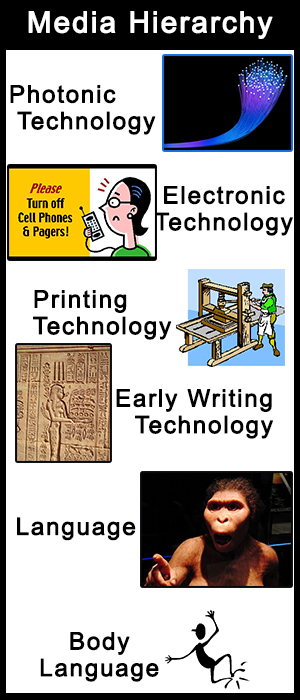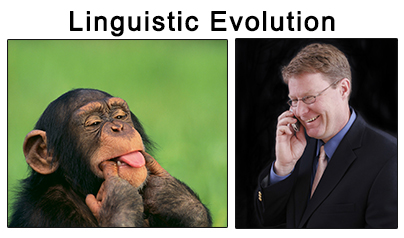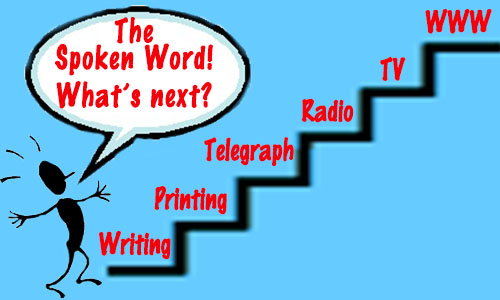Why is it that the Internet and the World Wide Web were created after the advent of television and radio? Why is it that television was invented after radio and not before? Why is it that the telegraph was invented before the advent of radio, but after the advent of printing? Why did homo sapiens discover writing after two million years of evolving spoken language?
Obviously, from our perspective living on the planet in the early part of the 21st century looking back at the world’s communications media history we take it for granted that certain communications media came first, second, third, and so on. In a way, these abovementioned questions seem absurd. But there must be some evolutionary logic underlying the progress from medium to another, and there must be some inherent relationship among the media.
 First, let us define the various communications media that are central to this analysis. The chart below puts each mega-media category in appropriate order, starting with body language:
First, let us define the various communications media that are central to this analysis. The chart below puts each mega-media category in appropriate order, starting with body language:
First, it should be apparent that as you move up the chart the prior communications media do not wither away. On the contrary, if history is any guide, we are still engaging in oral communication, we are still writing and reading, and we are now communicating over large distances electronically. In this century photonics only adds to the ease of communication and access to information–all on a global and, perhaps ultimately, interplanetary scale.
New communications technologies don’t replace older ones. They might modify their function and role in a society, but they do not go away.
The advantage of new technologies is that they provide the capability and characteristics to do something that wasn’t available before. For example, over the two million years of the evolution of spoken language—according to Robbins Burling author of The Talking Ape: How Language Evolved (Oxford University Press, 2005)—language evolved as a survival mechanism (his concept; my words, not his). It was also a sexual attraction device. Females of the species were attracted to the male of the species who had a greater mastery of using words and sentences; and therefore, concepts and ideas. In other words, males who could use language effectively and efficiently were more attractive than males who could not. Burling offers many other ways of describing the evolution of language in homo sapiens, but this is one of the central gists of his concept.
Another example is one that is mentioned often among teachers of media history. Prior to the advent of the printing press in the mid-15th century, Bibles, among other documents, had to be copied by hand—a very laborious process that could take years. However, with the printing press not only could a Bible be copied in a much shorter period, the press itself conveyed the concept of standardization. Pick up a printed Bible, any Bible of the time and they would all read the same, printing mistakes notwithstanding. In our present time the advent of the Internet and printers, email notwithstanding, has given rise to handwritten letters and notes—a more personal way of communicating. While the Internet/email provide instant interactive communications 24/7, 365 days a year on a global basis—no other communications medium had this characteristic before—it has also given rise to ways of more personal interaction. Handwriting used to be the only way people communicated. The typewriter notwithstanding in the interregnum, email transcends time and space, i.e., geographic distances don’t matter. Therefore, handwriting has become (again) an art form. And for those of us who have terrible handwriting skills, the computer is a godsend.
Further, you can put an older technology into a newer one, but not vice versa. In other words, you can go up the ladder of communications technology ladder, but not down.
You can put body language into spoken language, but not vice versa. In fact, body language has become part of spoken language. Spoken language (an analog medium) can be translated into writing (a digital medium), but not vice versa. You can put writing in print or typography, as some like to refer to it, but you cannot do the reverse. You can put printing into all manner of electronic media, but you cannot put electronic media into printing. You can put traditional photography and filmic technologies into electronic media, but not the reverse. Likewise, you can put electronic media into a photonic technology, but you cannot go backwards in the process. Technically, photonic technologies rely on electronic media to operate; they are not independent of one another, although the other communications media are.
Another observation it the time is has taken each mega-communications medium to develop, to wit:
- It took spoken language (orality) two million years to evolve
- Early writing did not evolve until about 6,000-5,000 years ago in the so-called Fertile Crescent
- Early typography (Gutenberg’s printing press) did not come onto the scene until about 560 years ago.
- Early electronic media, starting with the telegraph, did not happen until about 170 years ago
- And photonic technologies did not emerge until the early 1950s, about 64 years ago.
Rome wasn’t built in a day. But it is clear from the historical record that as we have moved from one dominant mega-communications medium to another, going up the ladder, the period of development of each has gotten shorter and much shorter.
 To return to the opening series of questions, it should be obvious that the more complex media could not occur before the less complex media had evolved. While this is not to say that spoken language is not complex and that the process of speaking is not complicated, it is perhaps understandable that it took a couple of million years for spoken language to evolve. This has become the foundation for all the other communications media. To put this another way, nature has said to us “If you want it to be good, effective and efficient, it’s going to take some time.” The evolution of spoken language is also significantly based on the evolutionary expansion of the brain and the re-arrangement of the voicebox in relation to the mouth and tongue about two million years ago. This kind of physiological evolution takes time. The dinosaurs did not evolve into birds overnight. It took 65 million years!
To return to the opening series of questions, it should be obvious that the more complex media could not occur before the less complex media had evolved. While this is not to say that spoken language is not complex and that the process of speaking is not complicated, it is perhaps understandable that it took a couple of million years for spoken language to evolve. This has become the foundation for all the other communications media. To put this another way, nature has said to us “If you want it to be good, effective and efficient, it’s going to take some time.” The evolution of spoken language is also significantly based on the evolutionary expansion of the brain and the re-arrangement of the voicebox in relation to the mouth and tongue about two million years ago. This kind of physiological evolution takes time. The dinosaurs did not evolve into birds overnight. It took 65 million years!
Further, the development of electronic and photonic media could not have occurred without writing and typography. These two latter media combined to allow later generations to read the works, thinking, and ideas of previous generations. This, in turn, allowed later generations to absorb the works, thinking, and ideas of previous generations and build on them. This relates to the meaning of illiteracy and literacy. Illiterates, with very few exceptions, do not conquer the world. Illiterates live in a static, non-progressive world. Literate peoples, on the other hand, have much greater opportunity to evolve.
The Information Age (and subsequently the social media age) happened after the Industrial Revolution. The Industrial Revolution happened after the Renaissance. Early writing appeared after the establishment of agriculture and the advent of counting (we know it as accounting). Agricultural societies only appeared after the development of language.
It is one mega-medium step after another.
If you have any questions or comments about this or any other of my blogs, please write to me at
meiienterprises@aol.com.
Eugene Marlow, Ph.D.
September 29, 2014
© Eugene Marlow 2014


